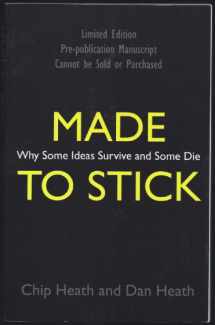
Made to Stick: Why Some Ideas Take Hold and Others Come Unstuck
ISBN-13:
9781905211562
ISBN-10:
1905211562
Author:
Publication date:
2007
Publisher:
Random House
Format:
Paperback
FREE US shipping
Book details
ISBN-13:
9781905211562
ISBN-10:
1905211562
Author:
Publication date:
2007
Publisher:
Random House
Format:
Paperback
Summary
Made to Stick: Why Some Ideas Take Hold and Others Come Unstuck (ISBN-13: 9781905211562 and ISBN-10: 1905211562), written by authors
, was published by Random House in 2007.
With an overall rating of 4.5 stars, it's a notable title among other
books. You can easily purchase or rent Made to Stick: Why Some Ideas Take Hold and Others Come Unstuck (Paperback) from BooksRun,
along with many other new and used
books
and textbooks.
And, if you're looking to sell your copy, our current buyback offer is $0.48.
Description
What is it that makes urban myths so persistent but many everyday truths so eminently forgettable? How do newspapers set about ensuring that their headlines make you want to read on? And why do we remember complicated stories but not complicated facts? In the course of over ten years of study, Chip and Dan Heath have established what it is that determines whether particular ideas or stories stick in our minds or not, and Made to Stick is the fascinating outcome of their painstaking research. Packed full of case histories and thought-provoking anecdotes, it shows, among other things, how one Australian scientist convinced the world he'd discovered the cause of stomach ulcers by drinking a glass filled with bacteria, how a gifted sports reporter got people to watch a football match by showing them the outside of the stadium, and how high-concept pitches such as 'Jaws on a spaceship' (Alien) and 'Die Hard on a bus' (Speed) convince movie executives to invest vast sums of money in a project on the basis of almost no information. Entertaining and informative by turns, this is a fascinating and multi-faceted account of a key area of human behaviour. At the same time, by showing how we can all use such cleverly devised strategies as the 'Velcro Theory of Memory' and 'curiosity gaps', it offers superbly practical insights, setting out principles we all can adopt to make sure that we get our ideas across effectively.


We would LOVE it if you could help us and other readers by reviewing the book
Book review

Congratulations! We have received your book review.
{user}
{createdAt}
by {truncated_author}


